The Aspley Guise Classical Academy
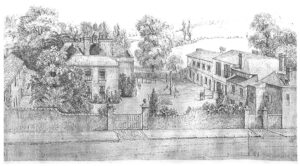
The sleepy Bedfordshire village of Aspley Guise was the home of a very successful Classical Academy school from the early eighteenth to late nineteenth century. Under one headmaster in particular, it was mentioned in the same breath as the famous establishments at Eton, Harrow and Rugby. Some families attended for several generations. The school occupied Guise House and the neighbouring premises, later used by Powage Press and now (2023) private houses and vacant offices.
The poor had very little education at this time, except for what came via the Church. The very well-off employed private tutors for their children. The middle classes, prosperous tradesmen and clerics (who could afford to) sent their boys off to Boarding Schools.
This research is based on the Bedfordshire Archives Community webpages about the school and education in Aspley Guise and some previous research by Mr. A. E. Ashfield Wright. He wrote to the Bedfordshire Magazine in 1949 asking for their readers to help in researching his ancestor, William Wright, Headmaster of the school during its most successful period. For eight years he pieced together the history and then published an article about the school in the same publication in Spring 1957. He also published an updated and comprehensive three-part history of the school in the Bedfordshire Family History Society magazines of 1979. Some of his papers are copied at Beds. Archives [CRT130ASP21] including a list of masters and owners, transcripts of deeds and an inventory of the house contents in c.1778.
References in this research are to the Bedfordshire Archives collection unless otherwise indicated. I’ve divided the story into the various Headmasters.
c.1718-1734 – Thomas Gressam
The earliest known Master of the school was Thomas Gressam, a local yeoman of Husborne Crawley, who had the support of the Quaker How family who lived in Aspley Guise. His school prepared the sons of gentlemen for careers in the services, church and commerce.
The exact start date of the school has never been discovered but A.E.A Wright found a will by Thomas Gressam’s cousin, dated 1718, in which he left 10 acres of land in nearby Husborne Crawley to Thomas, “…the Schoolmaster of Aspley Guise…”, yet the Aspley Guise Parish Registers record a death of Sanford Midellton, ‘a schollar boy’, in June 1703, so it may have been earlier.
Facts about Gressam are sparse, but he was certainly in Aspley Guise before the date of his cousin’s will, as he gave 6d. towards an appeal made in Aspley church in 1709 to raise funds for 13,000 German migrants who had taken up residence in Blackheath in south London. He also appears as a Churchwarden in the parish registers for 1716-17 and 1717-18.
Bedfordshire Archives have a letter [HW68] from Gressam to Richard How, who was staying at the Three Crowns & Key, in Grace Street, London, sent on 17th February 1723/4. It gives news of local property sales etc., but in a postscript, he asks How to help find new business for his school; “If any of your acquaintances have sons to put to school, I shall be obliged if you please to recommend, as the smallpox has caus’d some vacancies”. However, of the 23 burials across the two years of 1723-1724 in Aspley Guise, 17 were females and the only possible death from the school is the nine-year-old Charles Mon(c)k, the son of a London merchant. Perhaps other parents had withdrawn their children due to fear of the raging epidemic.
Apart from his being a witness in several local legal deeds around this time, not much else is known about Gressam’s time in charge. He made a will on 14th November 1733 leaving his property in and around Aspley Guise and Husborne Crawley to his family and friends. He was described in it as a ‘Schoolmaster’ and stated: “I give and bequeath unto my Usher Robert Sawell – Harris’s “Lexicon Technicum” and Leybourn’s “Cursio Mathematicus” and desire that he may succeed me in the school…”
Gressam died relatively soon after and was buried at St. Mary Magdalene & St. James at Husborne Crawley on 10th July 1734, noted as a “schoolmaster from Aspley” in the burial register.

1734-1770 – Robert Sawell
As bequeathed, Robert Sawell, already a long-serving assistant at the school, took over. Sawell started at the very bottom of the school hierarchy as a yard-sweeper and boot-cleaner. From the Northampton Mercury, 9th December 1734 (as transcribed in the Autumn 1994 Beds. Magazine):
Whereas I am informed that there has been industriously reported that the Boarding School at Aspley in Bedfordshire, kept by the late Mr. Gresham, will not be continued, I therefore think it proper in this manner to inform the Publick that the Report is entirely malicious and groundless, and that I who have been his assistant for upwards of 14 years, since his decease, kept on the same and do intend to continue it. Where all Gentlemen, who are pleased to send their Sons may have them taught Latin and Greek as well as Writing and Accompts with all possible Care, and may assure themselves that they will be taken proper Care of in all other Respects. By their humble servant, Robert Sawell.
He and his wife Elizabeth buried two of their children in Aspley Guise; Robert in 1734 and Ann in 1735. They had also baptised daughter Susanna in 1739 and had another, Elizabeth, in c.1747. There is a map of Aspley Guise from 1745 showing the landholders under the old strip-field regime. Sawell is shown as owning the school, an area in the Square now housing the Moore Place Hotel and a few scattered strips in the field to the west of Mount Pleasant – totalling one acre and one rood. Yet just 16 years later in the Enclosure Award of 1761, he was awarded 85a. 2r. 11p., equalling over 8% of the village land and becoming the fourth largest landholder in Aspley Guise, so he must have been accumulating land in the meantime at every opportunity.
The school was by now attracting pupils from around England and maybe further afield. There are a couple of first-hand accounts of him in letters written by the How family; his friends and backers of the school. Richard How wrote a letter (HW88/29) to Silena Ramsay (who later became his wife) which mentions the misfortunes in Sawell’s family, including this threatened murder by a foreign student in May 1761:
Neighbour Sawell’s family have lately had abundance of Trouble, one of his Ushers died of a fever, many of ye boys were ill, his nephew Billy Sawell who officiated also as an Usher gone home consumptive, not likely to recover, his servant scolded in brewing, his wife’s dangerous accident, and since his going to London, a great disturbance occasioned by a foreigner who boarded with him for the sake of learning English, being recommended by Verney’s wife; he quarrelled with T. Sawell and was so enraged at being called Fellow and like terms, he swore revenge and felt for his pistols which he usually carried in his pockets but he fortunately forgot when he changed his coat or I suppose T. S. would have been shot. On his going upstairs for them, T.S. went out and they were so much alarm’d, they kept him out of the way until their Boarder was gone, who staid only until the next day and at his departure vow’d he would have satisfaction…
It goes on to say the ‘aggrieved’ student was about 45 years old and it appears he had obtained a place at the school to learn English by deceit and the many stories he had given about his life were disbelieved. “Verney” was presumably the Earl Vernay of Claydon House?
Beds. Archives have an invoice from the school [HW83] covering 15th March to 15th December 1762, made out to Mr. Thomas Ramsay from Robert Sawell and the receipt, dated 7th February 1763, for payment of the debt. It was transcribed in Aspley Heath School’s “History of our District” (second edition of 1962 only):
Mr. Thomas Ramsey Dr. From 15 March to 15 December, 1762 £. s. d.
Paid for Shoes 2s. 3d., Mending Cloaths 2d. 0 2 5
Paid to Barber 1s. 4d., A Spelling book 1s. 0 2 4
A Common Prayer Book 0 1 6
For News History &c. 0 1 0
Copy books Paper, Quills and Ink 0 4 7
To him at 2d. per week 0 6 6
For his sound Education and teacher’s time 10 0 0
Received 7 Feb. 1763 the full contents. £10 18s. 4d.
Wavendon, Robert Sawell.
After 36 years in charge of the school, Sawell died in early 1770.

His son-in-law, Francis Moore, administered his estate, advertising on 9th April in the Northants Mercury for any debtors or creditors to come forward. Helpfully, 1770 is the year from which the online British Newspaper Archives have made the Northampton Mercury available, which also covers the Bedfordshire news of that time. Francis Moore had come from Somerset to attend the school and, whilst still a pupil, had married Sawell’s daughter Susanna in 1766. Moore went on to be a very wealthy land owner in the district and planted all the woods we see today around Aspley Heath etc. The house he had built as his family home, on land he inherited from his father-in-law, is the building now used as the Moore Place Hotel.
For the next fourteen years, Moore conducted a feud with Richard How the younger of The Old House, of the same How family who had helped set up the school. This arose when Moore packed a vestry meeting and attempted to get Richard How the elder’s land assessed for payment of the parish poor rate at an unfairly high level. The younger How said Moore had falsely accused his father of “ruling the parish” and that he had “…insulted him grossly by Expression of Contempt, laughter, virulent invective, and the charge of fraud and dishonesty…” – strong words for the time.
In March 1779, Richard How of Aspley wrote a letter [HW87/319] to his sons which included “A list of innumerable tales of industry & virtue rewarded by success, & idleness & vice punished”, which included these lines about Robert Sawell:
Our late neighbour Sawell came to the School a poor boy, performed the most servile offices, as sweeping the yard, cleaning shoes, etc. By his diligent attention to the instructions he received in requital for his services, he profited so well that he was employed as usher, & succeeded his master, by industry & frugality was enabled to bring up his family & provide for them handsomely, & to give his son a university education, who is now in thriving circumstances…
In another letter left by How, [HW50] thought to have been written in 1771, he said that Sawell “sometimes indulg’d his scholars with a holiday and to amuse them, found something for them and the ushers to do in the fields in hay time or harvest”. He certainly held enough farmland locally that the free resource of useful labour would have been of great benefit at busy times.
Thomas Sawell, Robert’s son who had been to university, later became the Rector of Battlesden and Potsgrove.
1770-1780 – James & Elizabeth Vaughan
The next Master in charge of the school was James Vaughan of Newington, London. He had married Elizabeth Sawell – Robert’s elder daughter – in Aspley Guise by licence in March 1770 and it may have been the plan for him to assist at the school anyway. He swiftly moved to advertise his school in the Northampton Mercury – from 18th June 1770:
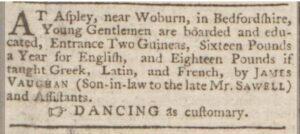
A Joseph Bevan of Beckerings Park sent a letter from the school [X347/9] in 1776. He is described in Beds. Archives catalogue as a pupil, but he mentions having a wife and the letter is mainly about the sending of an important land deed. A Joseph Bevan had been born in Ridgmont near Beckerings Park in 1732 so I think he was actually an assistant at the school. There had been a great deal of sickness at that time:
…We have had a great deal of affliction since you was hear [sic] the fever Polly had, my wife and all the children have had it and we have lost poor Billey with it, he was very ill upwards of a month. Thank God they have got well again.
Yet Vaughan did not spend very long in charge of the school – he died in July 1778, just eight years after taking over. He was buried in Aspley Guise and noted in the Burial register as a “Schoolmaster”. The same register had also recorded the burial of a Thomas Powell – “assistant at the school”, in August 1777 and two deaths of probable pupils are also recorded around this time – Charles Hunter, – “little boy from school” in June 1775 and Thomas Surfling in March 1776 – “child from the school”.
Beds. Archives has a map of Aspley Guise [X1/31] produced by a William Stevens, presumably a pupil who was practising his drawing and geography skills, or perhaps a drawing Master there, with “Mr. Vaughan’s Academy” mentioned in the title of a map, so it must date 1770-1778.

His widow, Elizabeth Vaughan, then ran the school with assistance from one of the existing employees, a William Wright, until he took over completely two years later.
1780-1807 – William Wright
Wright’s mother was a niece of Robert Sawell, the schoolmaster before Vaughan. Wright was born in Kempston in 1741. He had a very busy June 1780, as he was married at Aspley Guise on the 19th and signed the deeds purchasing the school the next day. A.E.A. Wright still had the 13-page inventory of school house contents [CRT130ASP21] which Mrs. Vaughan sold to Wright on 20th June 1780. These are the first two rooms listed in it:
Attic Story [sic] No.1 Inner Room
Four bedsteads with sloped crimson cloth furnitures
Four feather beds 4 bolsters
3 blankets, 2 rugs, four quilts
A cotton counterpane
A wainscot table and glass window, curtain and rod
No.2 Middle Room
3 four poster bedsteads with green oak furniture
2 bedsteads with sloped ditto furniture
5 feather beds, 5 bolsters
5 blankets, 5 quilts
5 cotton counterpanes
A wainscot bureau bedstead with a crimson check curtain
An oak chest and cloth basket and chair
In all, 30 rooms are listed likewise, including a “Writing Room”, “Dancing Room” and “Brewhouse”. The total number of beds throughout the property, including those of Mrs. Vaughan and the maidservants, was 69. For these contents, Wright paid £545 19s. 6d. by £300 in cash and a Bond for the remaining amount, signed by Wright and his father-in-law. Yet Wright was only leasing the actual building from Widow Vaughan, as A.E.A. Wright also had an original seven-year lease, active from June 1780, for £40 a year (with option of another seven) of the “Messuage or tenement with Schoolhouses, Playhouses for the Scholars, Barns, Outhouses, Gardens, Buildings, Hereditaments and Premises” and a close of pasture called The Powage along with other garden grounds. There was a contractual obligation on Mrs. Vaughan to keep the buildings in good condition, but Wright had to pay for the carting of any materials to site, any workmanship and specifically supply beer for the labourers! Widow Vaughen later remarried, to a Mr. Robert Martin, who had witnessed this lease.
In April 1782, Richard How, acting for the Rector who was not then resident, had to compile answers to a circular questionnaire about the population of the village. He replied [HW60-62] that there were 167 males, 238 females in 82 families “besides single persons” and “Women chiefly Lacemakers, the men employed in Husbandry”. He then adds “besides a very good School”. He lists the occupants as William Wright, Master and Assistants – 9, Boarders – 97, servant men and boys – 5, Mistress and friends – 4 and women servants – 6. A total complement of 121. A.E.A. Wright thought that there were between 100-250 boarders at times.
The Aspley baptismal register shows a William Stuart as baptising three children between 1782–1785, while he was working as an ‘Assistant at the school’. This was also recorded when his wife, Mary, was buried in Aspley in 1787.
In January 1782, two ex-Aspley Academy teachers, Messrs. Pars & Curtis, set up their own business in Newmarket, advertising the new venture in the Northampton Mercury. The Aspley Academy must have had a good enough reputation to use it as marketing for their new school:
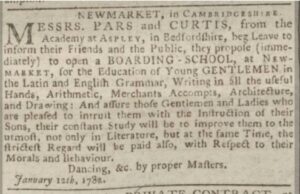
The owner of the school buildings (presumably still Mrs. Vaughan) put the freehold of them up for sale in March 1787, forcing Wright to issue a statement in the same Northants Mercury issue of his intention to continue his business activity:
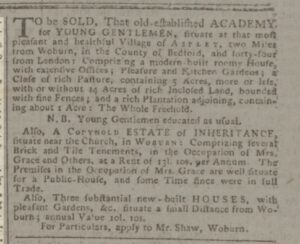
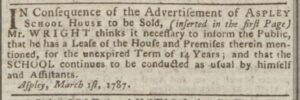
A later advert specified that Wright had a 14-year term of unexpired lease of the school, for which he was still paying £40 per annum (described as “much less than its real value”). The sale took place at the George Inn, Woburn on July 27th.
Pupil Thomas Adams wrote home to his father in Wing, Bucks. in 1789 that the young gentlemen had acted in a school play called “The Gamester” and a farce called “The Lyar”.
Whoever the new owner of the school was after the 1787 sale, they allowed the existing lease to Wright to continue. In January 1790, Wright was listed as a “schoolmaster” when he took out a Fire Insurance policy on his school [Lon. Met. Archives – CLC/B/192/F/001/MS11936/367/565351]
Beds. Archives has a manuscript list of 128 pupils at the school in 1788 [OR2071/390] recorded by one of the Orlebar family. [Attached as an appendix.] The Aspley Register also holds the records of two deaths of pupils from around this time – Alex Douglas, a “boy from the school” in November 1783 and William Evans “from the school” in October 1788. There is no precise date on some notes made by Richard How (HW60) but it is believed to be around 1790, which mentions that the school then had about 140 boarders.
Wright’s first wife, Margaret (nee Arrowsmith), died whilst in London in January 1792, aged just 32, after two days’ illness, according to her memorial stone in Aspley churchyard. They had had no children. Someone of Wright’s standing and position would have been expected to have a wife, so it is of little surprise that he was married again within six months, to a Mrs. Mary Howe, the widow of John Howe, surgeon of Leighton Buzzard, the marriage taking place in London on 28th June. Her maiden name was Queneborough, of the Dunstable family.
An ex-pupil, who had also been an assistant at Aspley, went off to start his own school nearby in Woburn. Jospeh Daniel started up a school along the same lines as the Aspley Academy, but in a startlingly modern twist for those time, also taught young ladies! The Northants Mercury, 23rd March 1793:
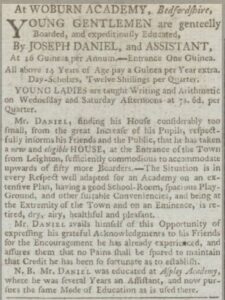
He then employed Rev. Mr. F. Stoddart, lately the classical teacher at Aspley, according to the Northants Mercury again, 4th January 1794:
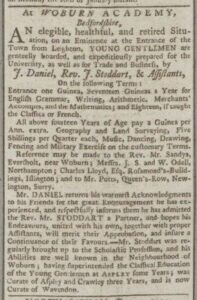
The Wrights baptised their nine children – William Quenesborough in August 1793 (possibly died 1796); Mary Ann in February 1795; Frederick in June 1796; Archer in November 1797; Samuel in March 1799; Robert in June 1800 (died July 1800); Robert Sawell in September 1801 (died June 1802); Septimus in April 1803 and Elizabeth Sarah in December 1804 – all in Aspley Guise, where he is described as ‘Schoolmaster’ in the baptismal register each time.
Other education establishments also used Aspley as an example of their professionalism. Aris’s Birmingham Gazette ran an advert from an anonymous French gentleman, Chas. M., in July 1796, that he was available to teach French. His advert included this character reference from Wright:
These are to certify, that the Bearer, Mr. Chas. M. has been employed in this Seminary under my Direction as French Master, from the Third of February till Midsummer following, in which Capacity he acquitted himself with so much ability, that had not the Fatigue and Confinement been too great for him, he would have continued longer and it is my sincere Belief that he is a moral, religious, and sober Man. Given, & co., at Aspley, the 24th June 1786. (Signed) W. Wright.
A James Read had worked at the Academy as writing-master for many years, which was mentioned in his marriage notice in the Northants Mercury in April 1797, when he wed Elizabeth Arrowsmith in Tilsworth. The next year, Wright was having to advertise for staff for the school, as the last drawing master had left to work for the Government. This appeared in the Cambridge Chronicle & Journal, 5th May 1798:
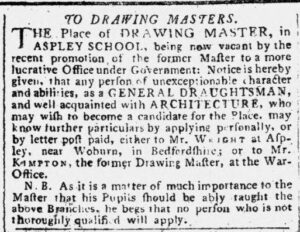
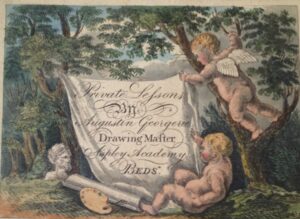
The impressive business card (above, which sold through Ebay many years ago) for his private art lessons, was produced by Augustin Georgerie, showing off his skills. We know from the Northampton Mercury that Georgerie died in January 1805 in London, whilst still employed as a Drawing Master at Aspley.
In 1856, Dr. Williams published his book “Climate of Aspley Guise -The Topography and Climate, in reference to their influence upon Health and Disease, as compared with celebrated English and Foreign Localities.” In the introduction, he writes of the school and the recollections of someone who attended it in the early 1800s:
In giving a more detailed account of the village of Aspley, it may not be uninteresting to recall the associations of the great academy which, in its palmy days, I am informed, amounted to no less a number than two hundred and thirty boys, now scattered to the four quarters of the world. The school having been discontinued now some twenty years; we shall content ourselves with a few leading facts only in its past history. Conversing with a gentleman who was a pupil at the school some fifty years ago, [1808] he thus accounted for a large share of the popularity of this once favoured seat of learning.
Mr. Wright, the second founder of the school, was a man of plain common sense, united to a frankness of heart and liberality of disposition. His leading ideas were to engage well-qualified teachers; to keep liberal table; to enforce exercise and supply amusements. It is no wonder that such a man became both popular and successful; and it is recorded “that many sickly half-nourished London boys nearly doubled their weight in six months.” Half-holidays were generally given upon birthdays, and all such occasions giving a healthful stimulus to both the mental and corporeal powers by relaxation from daily routine.
The same gentleman states that, as a rule, there was little or no illness in the school, and fevers scarcely ever known. From Mr. Wright the management of the school was transferred to the Rev. R. Pain of Pembroke College, Oxford, who conducted the institution with much ability for many years. The schoolroom still remains, and fine old house (enlarged by the late proprietor), over which the bell still hangs in its accustomed place, though its tones have long since ceased to animate the youthful spirits who once obeyed its summons.
Aspley School became celebrated not only for the amount of classical lore imparted to the boys, but for the foundation thus laid for a good manly constitution; undoubtedly an important element of success in the battle of life.
The success of the school swelled not only the village population but also the congregation of the local church, St. Botolph’s. Up until 1799, the boys had occupied a gallery over the north aisle approached by an outer staircase, but this became so cramped that Wright took it upon himself to suggest an alteration to the church [ABF3/12]:
The humble petition of William Wright of the Parish for Aspley Guise in the Archdeaconry of Bedford and Diocese of Lincoln, Schoolmaster, sheweth that your Petitioner is an inhabitant of the said parish of Aspley Guise, and is the proprietor of a dwelling house where he now resides and is a constant Resorter to Divine Worship when performed in the said church, and that he is engaged in a considerable school for the education of youths, but he is destitute of a convenient seat or pew in the said Parish Church for himself and family, wherein to perform the duties of such worship, and your Petitioner further shows that there is a convenient place at the West End of the said church, near the belfry to erect and build a gallery with a convenient stairway to the same, containing in length 32ft and 9ft in width to stand on columns, and entrance thereto to be on the South side of the Parish Church, which gallery he is desirous of having, and appropriating to the use and benefit of himself and family, to sit, stand, kneel and remain in during the time of Divine Service and Sermon, exclusive of all others.
The church authorities agreed to his request on 1st May and so he gave up his old space (except for a place for his servants) and he and his pupils were accommodated in a raised gallery instead (although how much noise 100-150 small pairs of feet made on the undoubtably wooden flooring of the gallery above the pious of the village is anyone’s guess…) The gallery seems to have still been in place in January 1845 when a writer in the Northampton Mercury, who signed himself off as “W.A.”, rather caustically described St. Botolph’s, saying: “The preservation of the miserable organ, and the gallery, is to be regretted: light, which is much wanted in this part of the church, is consequently excluded by this trumpery erection.” The writer was actually John Martin, the librarian to the Duke of Bedford at Woburn Abbey.
Other news snippets give reports about the school. An extreme hail storm broke all the windows in the north-west front of the Academy in August 1800. (Northampton Mercury – 30th August 1800.) The school had farm land locally to supply itself. A robbery was reported in the Sherborne Mercury in December 1800, when enterprising rustlers simply corralled Wright’s flock of sheep into a pen and picked out the best ones!

Beds. Archives has a circular [AD3276] sent out by Wright in about 1801 with the bills to parents, asking them to consider making a voluntary contribution as well, due to the cost-of-living increases. This accompanied a bill for school fees of £24 5s. 6d.
Mr. Wright, at the request of several of the parents, embraces this Opportunity of addressing his worthy Friends in general, on the continued high price of Provisions, and assures them that notwithstanding his School has been flourishing, both as to number and connexion, during the whole time of Dearth, beyond precedent, yet, having sustained so considerable a Loss, after all his anxious concern, particularly, the last Year, he could wish to be favored with some moderate remuneration, by way of voluntary Contribution, rather than make any further advance of Terms; especially, as the growing Crops, not only of Grass but likewise Corn, are at present so promising as encourage him to hope that Provisions will become more moderate in price after the ensuing Harvest; consequently, no further Application of this unpalatable nature with the necessary in future: Therefore, he hopes that after a candid examination of the Pupils, and a mature deliberation on the reasonableness of his Plea, he will be thought justly entitled to a continuance of that generous Patronage which he has experienced for more than twenty years; and, in return for this Act of Liberality, not Obligation, his kind Benefactors may rest assured, that neither Pains nor Expense shall be wanting to promote the Improvement, Health and Happiness of all such young Gentlemen as now are and may hereafter be kindly recommended to this ancient Seminary.
Mrs. Wright begs to unite in grateful thanks for all former favors, and promises a continuance of her utmost Endeavour to merit Approbation by maternal attention, in her domestic Department,
According to custom, Mr. Wright herewith sends his Bill, which he sincerely hopes will be found moderate and just; but if, inadvertently, any Error should have escaped his vigilance, it shall be most willingly rectified at the opening of School, on the 3d. of August; when such Students as may be intended to come are desired to attend, punctually, on that day.
Sadly, the following report doesn’t give a location of the incident, but it was reported in the Chester Chronicle of 4th February 1803 that a quick-thinking coach driver told would-be robbers that the school trunks he was transporting were full of wild animals and shouldn’t be opened:
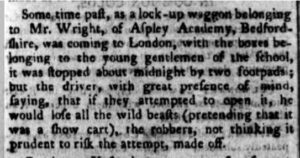
The Wright’s now had six surviving children of their own to look after as well as a school full of pupils – no wonder Mrs. Wright looked for some assistance; someone who needed to be “remarkably good tempered”(!) The Northants Mercury 9th June 1804 (but practically the same advert was running again in June 1805):
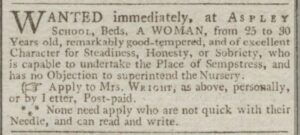
A Mr. Yeatherd had been taken on as Drawing Master after the death of Mr. Georgerie. He offered lessons to private individuals and other schools whilst so engaged. Northampton Mercury, 23rd February 1805:
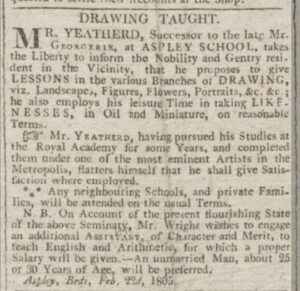
The British Press, of 10th December 1806, gave a report of a play performed at the school for parents. Interestingly, it gives the whole cast list for their production of “Richard III” and also the entire monologue performed by a Mr. Hope beforehand:
ASPLEY SCHOOL. The Tragedy of King Richard the Third was performed by the Young Gentlemen of Aspley School, in Bedfordshire, on Wednesday last. The piece went off with great éclat; and the performance was attended by a great number of Ladies and Gentlemen from London, relatives of the Young Gentlemen of that popular Seminary. The piece was cast and supported as follows:
King Henry the Sixth – Mr. Mercer
Edward, Prince of Wales – Master Wright
Richard, of York – Master Coghlan
Richard, Duke of Gloucester – Mr. Bishop
Duke of Buckingham – Mr Reeve
Henry, Earl of Richmond – Mr. Slater, Sen.
Duke of Norfolk – Mr Potts
Ratcliff – Mr. Kimpton
Catesby – Mr. Pratt, Sen.
Lovell – Mr. Bartlett, Sen.
Oxford – Mr. Lincoln
Lieutenant of the Tower – Mr Henderson, Sen.
Lord Stanley – Mr Ashfield, Sen.
Lord Mayor – Mr. James, Sen.
Tyvel – Mr. White
Blunt – Mr. Platt
Farent – Mr. Gilbert
Dighton – Mr. Mann, Sen.
Elizabeth, relict of Edward – Mr. Hope
Lady Anne – Mr. Sabin
Duchess of York – Mr Henderson, Jun.
Servant – Mr. Overstall
Guard. – Mr. Gordon
Gentlemen, Ladies, Guards, and Attendants, by Messrs. Willis; Priddy, Collins, Shouler, Gardner, Sen. Griffin, Pell, and others.
The Play was preceded by the following Prologue, spoken by Mr. Hope… [not transcribed]
Under Wright, the school reached its highest watermark. The boys sent to the Classical Academy came from all over the country and from a high level in society; one boy was the son of Major General George Bowness of the East India Company; another became the London architect Sir Robert Smirke who began the redesign of Milton Bryan church in the 1820s and also designed the British Museum and the General Post Office in London. Another boy, John Joseph Stockdale became a publisher in London. He infamously published the memoirs of a high society Mistress, Harriette Wilson, in 1826. Several of her previous rich and titled conquests were contacted before publication and offered the chance to be removed from the book – for a price. The reply from the then Duke of Wellington of “Publish and be damned!” became a famous line. When it went on sale, a crowd ten deep is said to have formed outside Stockdale’s bookshop, clamouring for copies. It led to Stockdale suing Hansard after the book was discussed in Parliament and referred to as “indecent”.
Stockdale published his own work too and his “Encyclopedia for Youth; or, an Abridgment of all the Sciences, for the use of Schools of both Sexes” appeared in 1807. It contained a dedication to his old schoolmaster, William Wright, with the following words:
Dear Sir. After having looked round amongst all my connections, notwithstanding the inducements of high rank and fortune, I cannot find any to whom my own heart tells me I can dedicate this, my first publication, with such propriety as to you. The work being intended for schools, how far it is likely to be of use to them, none can more readily decide than yourself, who have had the charge of one of the most considerable private academies in this country for, within my own recollection, between 20 and 30 years. The master of that establishment, where I spent so much of my early and pleasant years, will, I am sure, recognise, if with surprise, with satisfaction also, the grateful tribute of an old pupil. Sensible of the advantages which, while under your anxious care, I enjoyed, in common with my fellow students, many of whom I daily see rising to eminence around me, I do not hereby acquit myself of, but only in part discharge a debt, to which you have every claim. Nor am I less sensible of the benefit I derived from your arduous and unremitting instruction, than of the paternal kindness which is uniformly a characteristic of your hospitable roof. That the success you have met with may attend every individual of your family, is the heartfelt prayer of many besides,
My dear Sir, your affectionate and sincere well-wisher, John Joseph Stockdale. London, 22nd October 1806.
Apparently after a long illness, William Wright died in December 1807, aged just 55 and was buried in Aspley churchyard with his first wife, under an impressive slate memorial stone. His second wife did not join them until 1844. His obituary appeared in the Morning Post of 12th December:
On Saturday last, at Aspley, near Woburn, Bedfordshire, after a lingering illness, which he endured with more than common Christian fortitude, Mr William Wright, for many years Master of the well known School there, which he conducted with unsullied integrity, with considerable ability, with intense application, and with the utmost liberality, and with such distinguished success, as to have raised that, which he found a private, almost into the rank and consideration of a Public School. R. Wright has left a widow, and seven children, and has died sincerely lamented by his family, his friends, and by those whom he indeed always considered as his friends, his Scholars. We understand that the Business of the School will be continued, and that Advertisements are preparing, in which its arrangement will be detailed.
His will [V401] left £200 to his wife to be paid in one month but all his property and other worldly goods were left to his executors to set up a trust in order to provide his wife with £100 per year for the rest of her life. The Rev. John Parry of Woburn, previously an assistant at the school, who now ran his own establishment, was one of the trustees.
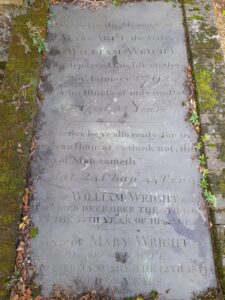
His loss was felt keenly by his ex-pupils and by Mr. Stockdale, the publisher, in particular. He arranged an appeal for a monument to be erected – this appeared in the Northampton Mercury on 19th March 1808 and also in the Morning Post a few days later:
Tribute to the late Mr. Wright, of Aspley. At a Meeting of Gentlemen educated by Mr. Wright, at the Academy of Aspley, near Woburn in the County of Bedford,
Resolved – unanimously, That a respectful Tribute be paid in the Memory of the late MR. WILLIAM WRIGHT, by the Erection a Monument wholly at the Expence those educated under him.
That Subscriptions be received by STOCKDALE, Jun. Bookseller, No. 41, about the Middle on the North Side of Pall-Mall; the Rev. Mr. Parry, Woburn; and Mr. Barnard, Banker, Bedford.
This Meeting having learnt with more Indignation than Surprise, that unprincipled Attempts have been made, in Consequence of their much-esteemed Master’s Death, to diminish the numerical Respectability of Aspley School;
Resolved – unanimously, That, convinced of the Adequacy of the Arrangements made for continuing that Establishment in its full Vigour, we will collectively and Individually exert our utmost Endeavours zealously to promote the Interest of Mrs. Wright and Son, who now carry on this celebrated Academy for the joint Benefit of the Family, which consists of the Widow and seven Children.
J. STOCKDALE, Chairman. No.41, Pall-Mall, London, Feb. 28th, 1808.
Reminders were published several times in July that year, but money must have been coming in, as an ornate tablet duly appeared in Aspley Guise church, although I cannot find a report of the installation.
![The memorial to William Wright in the north aisle of Aspley church [Beds. Archives]](https://www.mkheritage.org.uk/wsc/wp-content/uploads/sites/17/2023/12/wr13-1-200x300.jpg)
Near this Spot are deposited the Remains of Mr. WILLIAM WRIGHT for many years MASTER of ASPLEY SCHOOL, which he so exalted in Respectability by judicious Discipline, by Kindness towards merit, by literary, moral and religious Vigilance, As to deserve the Title of its second and more successful Founder. He was a Friend to all his Scholars, who therefore became his Friends and venerate his Memory. As a Man he was just and liberal, as a Christian pious and resigned. It pleased he Almighty to afflict him with a painful and lingering Illness which he bore with exemplary Patience, cheered by the faithful Hope of a happy life beyond the Grave. He died December the 5th 1807 in the 55th Year of his Age, leaving seven Children and a Widow, whose Affection hath erected this Memorial.
His tomb is indeed nearby, as it lies just outside, behind the wall on which the tablet hangs, against the church wall to the north.
1807-1821 – Mary Wright & Rev. Henry Nicholson
Widow Mary Wright continued the school. To assist with it, she took on Rev. Henry Nicholson, who came from the Free Grammar School in Northampton, where he had been working for nine years as Second Master. Details of what would happen were published in the Northants Mercury, 9th January 1808:
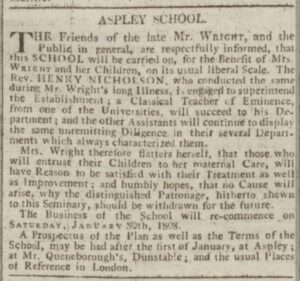
Two weeks later the same newspaper was advertising a new school at Buckingham being opened by Messrs. Davies and Exton, which played off Davies’ connections to the Aspley Academy:
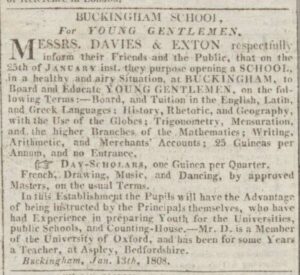
A.E.A. Wright illustrated his 1959 article with a School Prospectus from about this time, found used behind a painting as backing. The text ran:
At Aspley, a pleasant village near Woburn, Bedfordshire, young gentlemen are boarded and educated in English, Latin, Greek, French, Writing, Arithmetic, Merchants accompts, Algebra, Geometry, Trigonometry, Navigation, Pertinent Surveying together with Geography, the use of the Globes and other useful Parts of the Mathematics, by Mrs. Wright, her son, and proper assistants, for 25 Guineas a year without entrance.
Dancing, Drawing, Music and the Military exercises by the best Masters on the usual terms. The pupils whose parents desire it may have the additional advantage of being privately instructed in any of the above branches after school hours at one Guinea per quarter. Students in this ancient seminary are liberally treated and expeditiously qualified for the learned professions, the Army, Navy or the offices of trade and business. Further particulars may be known by applying as above by letter or personally to:
Mr. Hastie, Norton Street
Mr. Pitt, Portland Street
Mr. Hook, Charles Street
Mr. Ewbank, Bond Street
Mr. Tilley, Duke Street
Mr. Stockdale, Pall Mall
The Rev. Dr. Coghlan, Northumberland Street, Mary Le Bone
Mr. Lebrow, St. John’s Street
Mr. Hooper, Long Lane
Messrs. Morris & Henderson, Lombard Street
Mr. Stockdale, Holborn
Mr. Kent, Holborn
Mr. Hope, Upper Clapton
Mr. Howell. Garrawaye Coffee House
Mr. Marchant, Drury Lane
Mr. Queneborough, Spanish Town, Jamaica
Messrs. Lockington and Co., Finsbury Square
Mr. Bartrop, Holborn
Mr. Edgar, Mincing Lane
N.B. The Reverend Henry Nicholson who for some time conducted the Classical department and who so satisfactorily superintended the school during Mr. Wright’s long illness, is engaged to continue his services during the minority of his son. The students from town are conveyed to and from school at Christmas and Midsummer in post chaises under the Masters care but if any should not be ready at the appointed time, they may be safely conveyed by the Woburn coach from the George and Blue Boar, Holborn every morning at seven.
Mrs. Wright or Mr. Nicholson may be seen in the vacations at the George Street Blue Boar, Holborn. On account of many expensive improvements for the better accommodation of the students, the terms of admission to all our new pupils over reaching the age of 12 years are unavoidably advanced to 30 Guineas per annum.
Subscription to the Cold Bath, One Guinea per annum, to the library, half a crown per quarter. N.B. Bills to be paid half yearly and a quarters notice of a student’s removal.
No doubt the Stockdales are those that helped organise the memorial tablet to Wright, the others are probably parents or ex-pupils.
Running such a large school required more than just teaching assistants. There were also other servants required, such as a housekeeper and matron to look after the boys. This advert appeared in the London Morning Herald in June 1805:
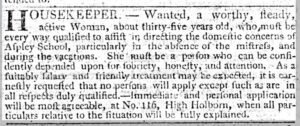
Mrs. Wright also advertised for staff in 1808, requiring “a gentleman of a very high standard” to join the school as the Classics Master. This appeared in the Oxford Journal on 16th January:
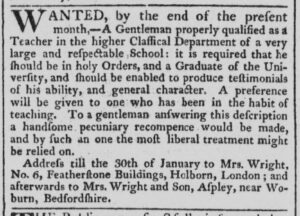
… and in August 1810 advertised for a new gardener, also in the Northants Mercury:
WANTED immediately A single YOUNG MAN, between the Age of 20 and 30 Years, a GARDENER. Anyone who has a perfect Knowledge of the Cultivation of the Kitchen Garden, and can be well recommended for Honesty, Diligence, and Sobriety, will meet with very liberal Encouragement and Treatment, by applying to Mrs. WRIGHT, Aspley School, near Woburn, Bedfordshire.
One of the pupils around this time was Thomas Blackwell, who later took over an existing oilman and salter’s company with a business partner, to which they had both previously been apprenticed and decided to rename it after themselves, forming “Crosse & Blackwell”. His brother, Samuel Blackwell, went on to have a successful saddlery business. John Higgins of Turvey also attended the school, the family later giving its name to the Higgins Art Gallery in Bedford.
Thomas Askew is noted as an “assistant at school” when he baptised his son at Aspley Guise in January 1811, whilst in April 1812, an inquisition was taken at Aspley Guise upon the body Thomas Clarke, “a servant the school there for many years” who had died suddenly “by the visitation of God”. Drawing Masters seem to make their living by taking private commissions as well as their school work. The position at Aspley was now in the hands of a Mr. L. Parez, who lived in Woburn. (Northampton Mercury, 22nd January 1814)
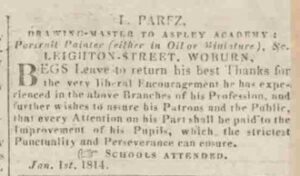
The Rev. Dr. Nicholson, who had assisted running the school since Wright died in 1807, left Aspley in June 1814 to take up running the Nottingham Academy (Nottingham Gazette, 10th June 1814). This left Mrs. Wright and her son Samuel running the school, although he was only about 15 years old. (Her other son William Queneborough Wright was away at St. John’s college Oxford, where he achieved his B.A. in 1814) Their short period in charge was not without incident, as Widow Wright had her house robbed in February 1815 and some belongings of pupils taken, which gives interesting glimpses into what the school uniform might have looked like. Northants Mercury, 4th February:
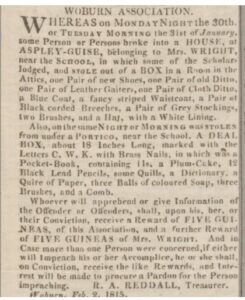
A new pupil at the school died after being there just eight weeks in September 1816. 14-year-old R. Iliffe, son of Mr. Robert Iliffe of Kettering, was a “very promising youth, of an amiable disposition, generally beloved, and his loss is much lamented his numerous relations and acquaintance”.
In an 1818 list of ratepayers of Aspley Guise, [HW1] Mrs. Wright was listed as holding a total of 228a. 1r. 11p. land locally. A.E.A. Wright’s Beds Magazine article concludes with this recollection of an ex-pupil from around this time, as related to his grandfather:
A letter written by my late grandfather, Frederick Ashfield-Wright, solicitor, of Hitchin, Herts., in the [18] nineties, relates that he met an old-boy from the school, then nearly 90 years of age, who had been at the school between 1813 and 1820 and was head boy before he left to go up to Oxford. His recollections were most vivid – he shut his eyes and said he could see everything as it was in the days of his boyhood; he remembered Mrs. Wright and the Rev’d. Nicholson when they ran the school, also a Dr. Radcliffe, an Oxford man.
The education in Classics and French was excellent, but he thought there was not sufficiently high pressure in Mathematics. Rugby, he said, was the only school in England, with the exception of Eton and Harrow, which could compete with Aspley, which was ‘undoubtedly’ the first private school in England. Half the clergy of the county, and almost every lawyer in Northamptonshire, were educated there, and the sons of bankers and many rich men, some of whom could afford to drive their four horses. As for eating and drinking there was nothing like it at any other school, said he, “Your grandmother partook of the same food as the boy’s and masters, and she was very particular and very kind and always showed unending anxiety for our welfare”.
Mrs. Wright stayed on until 1821, when she retired, the Wright family having run the school for 43 years between them. The press notification in the Northants Mercury, 2nd June, also introduced her successor:
ASPLEY, MAY 22, 1821. ABOUT twelve Months have elapsed since the Friends of Mrs. Wright were informed, that Mr. Wm. Wright would be succeeded in the Management of Aspley School by the Rev. Mr. Pain, she herself continuing to regulate her Department of the Establishment, such was then her Purpose – but feeling her Health gradually and materially impaired by the fatigues of her laborious Occupation, and knowing that Mr. Samuel Wright would, for sufficient Reasons, decline the future Superintendence, which it had been contemplated that he would succeed, she has resolved, at the urgent Solicitation of her Family, TO RETIRE FROM HER ARDUOUS SITUATION AFTER THE PRESENT HALF YEAR.
Mrs. Wright, in making this Communication of her Intention, cannot forbear to express the sincere Pleasure she experiences, at the Satisfaction which her Efforts have afforded to her Friends; nor can she conceal that Sense of partial Confidence, with which, during a long Period, Aspley School has been happily distinguished. That Confidence, under similar Circumstances of Responsibility, will, she trusts, as she Hopes, be extended its future Directors; an ENGAGEMENT HAVING BEEN ENTERED INTO WITH Mr. PAIN, WHO, IN CONJUNCTION WITH Mrs. P. WILL HENCEFORTH CONDUCT THE ESTABLISHMENT.
Mrs. Wright, in presenting her Successors to the wide Circle of her Connections, is influenced by the Belief, that in their Qualifications and Character, they are well adapted to promote various Wishes and Objects dear to parental Anxiety; and persuaded that they will conscientiously satisfy the numerous Obligations of their important Charge, she earnestly solicits the same Measure of Confidence may be enjoyed by them, which it will to her Source of never-failing Gratification that she has herself received.
ASPLEY SCHOOL, near Woburn, Beds. Rev. RICHARD PAIN, LL. B. having succeeded to Aspley School on the Retirement of Mrs. Wright, begs leave to State very briefly in this public Way, the general Management which will adopted in that long established School. The domestic Arrangements which, under the Directions of Mrs. Wright, have given such general Satisfaction, will be scrupulously adhered to. The old Method of Education which has gradually giving way during the time Mr. Pain has conducted the School, will be wholly superseded by the Madras System so ably and successfully pursued at Charter House, and when it is stated that Mr. P. owes his Education and Advantages in Life to that excellent Institution, and is in Communication with the distinguished Master at the Head of it, it may be hoped, without Presumption, that he is not unprepared to introduce some useful Improvements. This Plan, combined with the healthy Situation of the Village, suitableness the Buildings, and the moderate Terms of Instruction, will give to him, it is hoped, a fair Share public of Attention and Support.
A last note from this time are some initials found carved into a side panel of a window embrasure of the central room, first floor of Guise House, discovered by a later owner, Peter Calvocaressi:
H. French, June 18, 1821
H. Bellamy
C. W. R.
(?) Paxton
I. (?) Stevens
W Kleft
Dilke
T. Goodwin
R. H. Giles 1814.
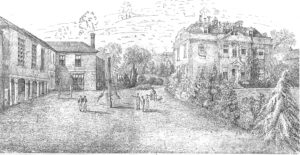
1821-1845 – Rev. Richard Pain
Pain was born 1774 in Banbury where members of the Pain family had been elected as Mayor no less than 16 times. He graduated from Oxford in 1793 and had the living of two parishes in Essex – Little Wigborough and Lindsell as the gift of the Lord Chancellor of Charterhouse, where he had been Head Boy. This had earned him a scholarship to Pembrooke at Oxford. He had been serving as Curate at Bletchley and Fenny Stratford but gave these up on taking over Aspley School.
He had married in 1800, in Bodmin, to one Elizabeth Fisher, with whom he had seven sons and seven daughters [FAC56]. She was the sister of Rev. John Fisher, who was vicar of Wavendon from 1805 until his death in 1846 and her brother William died at Waterloo.
Parker says Pain bought the school outright in 1825. A.E.A. Wright says it changed hands for £4,300 and the farms belonging to the school in Aspley and Husborne Crawley were later sold for £16,800, but it is not clear whether he means that sale was by the Wrights or the Pains.
Perhaps Pain had plans for a much smaller school, or perhaps he had invested in new furniture, but Mrs. Wright had to hold a sale of all the equipment that Pain did not want to take on and this included 35 four-post beds! The sale advert from the Northampton Mercury, 30th June 1821:
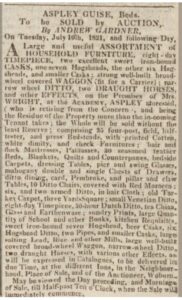
His advertisement in the Cambridge Chronicle & Journal on 11th January 1822 which shows that Wright junr. was still involved as an assistant at the school:
ASPLEY SCHOOL, BEDS. CONDUCTED by the Rev. RICHARD PAIN, LL.B. late of the Charter-House, Mr. SAML. WRIGHT, A. B. and Assistants. This School, which for nearly a century has, from its extended mode of Instruction, the healthy situation of the village, and the superiority of its accommodations, obtained a general notice and support, may now reasonably solicit more particular attention, from the successful introduction of the mode of teaching so ably pursued by the distinguished Master of the Charter-House. Mr. P. may add, that separate apartments are provided for Gentlemen desirous to read for Orders, or to prepare themselves for the University of Oxford or Cambridge; and as well for Foreigners who may wish to acquire a knowledge of the English Language.
He was advertising for a new baker for the school in the Northampton Mercury of 25th August 1827, requiring “a single man, with a full Knowledge of his business, and of a good character”. He advertised the School in the same paper from January 1831, pushing the languages teaching they could offer:
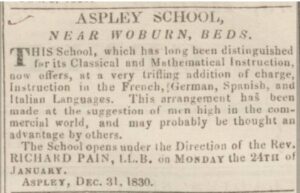
From 1832, there were regular notices of when the school terms would be restarting but these got smaller and smaller until they consisted of just a couple of lines. The 1833 Education Return survey for Bedfordshire, primarily looking at free schooling for the poor, mentions there was a private Boarding School in Aspley Guise with 30 male attendees.
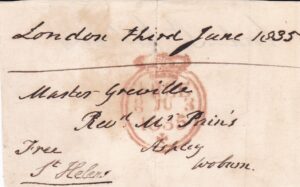
Mrs. Wright had not retired far away – she had first moved to The Old House, bought for her by her son Rev. Samuel in 1824, then later to Avenue House. She finally left the district in July 1839, having a grand sale of personal effects on her leaving, including “Household furniture, plated articles, linen, china, cut glass, small library of standard French works, choice cellar of wines, a four-wheeled chaise, with steady horse and harness, good beer casks and brewing plant, garden implements and numerous other effects…” She died in 1841. Their son, Rev. Samuel, later became the vicar of Drayton Parslow.
The Bucks Advertiser & Aylesbury News of 28th March 1840 reported that Rev. Richard Pain of Aspley Guise had had about 12 bushels of potatoes stolen from his ‘premises’, but this may have been one of the farms the school owned.
The 1841 census is the one of only two to capture the school whilst it was open. There seems to be two separate households listed in it. The first gives the Pain family: Richard Pain, 65 – Clergyman & Schoolmaster; wife Elizabeth Pain, 62, then their daughters Elizabeth Pain, 30, Ann Pain, 25, Mary Pain, 25 and Ellen Pain, 15. They lived together with the younger pupils and servants:
Robert Bagshaw, 15
Frederick Bagshaw, 14
Charles Barnet, 10
George Barnet, 9
George Bury, 9
Henry Gildhart, 9
Charles Gildhart, 8
Kedgevin Gough, 13
John Halcomb, 9
John Johnson, 11
Charles Purser, 12
John Purter, 10
Richard Ratcliffe, 14
William Ratcliffe, 12
James Rilly, 14
Charles Rilly, 12
William Rilly, 10
George Smith, 12
Richard Wilkins, 10
Alice Furney, 25 – Female servant
Anna Button, 19 – Female servant
Mary Richardson, 20 – Female servant
Ann Bowler, 25 – Female servant
Maria Shimeld, 30 – Female servant
… then a second household next-door shows more staff, the older boys, Pain’s son and more servants, including having their own baker onsite:
Henry Quartley, 20 – Independent
Thomas Eastman, 30 – Assistant master
Anthony Granard, 32 – French Master – Paris
George Bumett, 14
Thomas Ginger, 15
Henry Grant, 14
Richard Gresham, 15
Robert Gresham, 11
William Hitchcock, 14
Algernon Seby, 15
Alfred Jones, 15
Thomas Leete, 15
John Loveridge, 15
William Pettit, 13
James Rose, 15
James Rutter, 15
John Sanders, 15
John Simons, 14
Alfred Swaine, 12
John Thacker, 15
Whitbread Tomson, 14
Edward Whyly, 13
William Wroth, 12
Alexander Young, 15 – Jamaica
Henry Young, 12 – Jamaica
George Harriss, 22 – Baker
Noah Hart, 15 – Male Servant
Edmund Pain, 16 – Independent
William Best, 12
William Clarke, 12
Henry Fowler, 14
John Freeman, 14
James Gildhart, 16
Thomas Gildhart, 15
James Hill, 14
John Fenkens, 11 – India
Edward Wakefield, 11
Edward Platt, 15
George Platt, 14
Henry Stockdale, 15
Septimus Stockdale, 15
Thomas Andrew, 15
William Hill, 12
Some reminiscences of Aspley Guise in the 1830s-1840s were published in the Fleete Ruridecanal Magazine in October, November and December of 1903. Sadly, the author of the articles is not named.
The establishment, seventy years ago, consisted of the Rev. R. Pain and family, four masters, five or six maid-servants, a baker, a coachman, and a gardener, and over 100 boys. In earlier days there had been between 200 and 300 boys, and Chain House and The Rookery were masters’ houses.
The baker baked and cooked for the whole establishment, in an underground kitchen. The boys were not allowed to go into the village, but a woman named Susan Taylor, who kept a confectionery shop nearby, was allowed to take cakes, &c., into the grounds, where she had a small room, fitted with shelves. In this room she used to lock herself up, and then open a small barred hatch, through which she supplied the boys. On the top of the head master’s residence, now called Guise House, between the two lofty chimneys, was a large bell, which was rung every morning at seven for school.
The grounds on the west were enclosed next the road by a six-foot wall, with a wooden palisade on top. Here were also dormitories – since pulled down – with the “washing school” below. This was fitted with long troughs, divided, not quite to the bottom, into 18-inch squares, so that water pumped in at one end filled them all. The pump, with a large iron ladle chained to it, stood outside this block.
On the south were the school-rooms, for English, Latin, and French, and the ball-room (now Printing Works), and below these were rooms for masters and parlour boarders. A portico, for use in wet weather, ran along the front. On the north side was a long range of dormitories, called the “green rooms,” and below were the laundry and other offices. This block still exists. Dancing was taught once a week by Mr. Hambling, who came, I think, from Winslow. At Christmas the breaking-up was always celebrated by a ball, to which ladies and gentlemen from the neighbourhood were invited.
Pupils came from various countries to learn English – one, from Spain, called Figario, kept a pair of ponies and a lad in livery. Some of the parlour boarders kept horses, and hunted occasionally. Amongst the pupils were Barnards (3), of Stratton Park; Wroths, of Edgeborough; and Denisons (3): Carlisle Parker, Platts, &c. Some entries in the Parish Registers, and some initials carved in the old buildings, and on the big beech tree in the Shrubbery garden, are all the remains of this once flourishing establishment.
The school was still being advertised in January 1844, like this in Bell’s Weekly Messager:
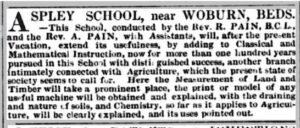
… but this notice of the reopening of the school in July that year from the Northants Mercury is the very last such instance I can find:

I therefore believe it either closed for Christmas in 1844 and did not reopen in 1845, or it might have operated the first half of 1845, as it was sold in September 1845. Pain sold the school buildings to a carpenter and straw-plait manufacturer, George Farr Arnold, for £950, who conducted his business out of them for at least a few years. A copy of the conveyance is still in local hands, from which this plan is taken:
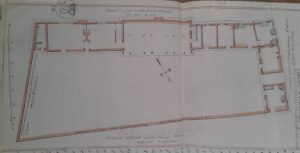
c.1845-1862 – Break Time
For almost 20 years, no education business was conducted on the premises. Then an advert appeared for the buildings to be let in September 1848:
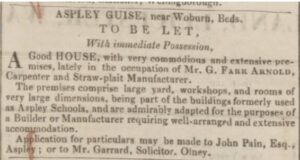
This was because Arnold had gone broke. His property was all sold by his creditors in November that year. Eventually he had to pay 3s. 2d. in the £ on his debts. The auction advert from the forced-sale of his residence in 1848 describes a large property with workshops and a bakery, so I believe this was the school:
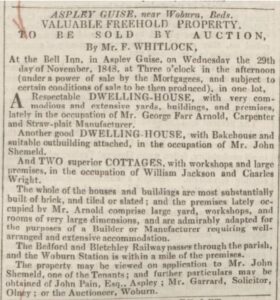
[Arnold moved to St. Albans, started again and built up another business in time. One internet source says he later became Mayor of St. Albans three times, but while he was certainly a respected Councillor and Guardian of the Poor, he was never elected as Mayor. He died in February 1897.]
By the time of the next census in 1851, the Pains are still in Aspley Guise, but there is no sign of any teaching going on – they had just a cook and a housemaid. His occupation in it is listed as “Without care of souls”, a somewhat sad-sounding expression but a standard one for a clergyman who was not officiating in a parish at that time. But they were back in ownership of the school. Had they re-bought it at the auction in 1848 or just reclaimed it as Arnold had defaulted on his purchase from them?
Richard Pain died in March 1854 and his widow Elizabeth in 1858, still in Aspley Guise. He was buried in the churchyard, not far from Wright. Their children had left Aspley Guise to start their own families. Two of his daughters married two brothers – Matilda was married in May 1841 to Augustus Turner, by the vicar of Wavendon (Rev. John Fisher – her uncle) in Aspley Guise church. Turner was an officer with the 1st Bengal Native Infantry of the East India Company. Matilda went to India with him but died at Barrackpore in September 1843.
Ellen Pain had married Augustus’ brother, Capt. Athill Turner, in India in 1852. He was also an Officer of the 1st Bengal Native Infantry. A son was born and sent back to England for schooling, but two daughters were still with them when the Indian Mutiny began. On 10th May 1857, both her daughters died of fever at Cawnpore – one on their second birthday and the other at just five days old. The Turners were there when Cawnpore was besieged that June and Ellen died of fever during the time the British were surrounded in an entrenchment. Athill “had both legs smashed” while trying to escape in boats on the river Ganges during a ceasefire which broke down and is thought to have been taken prisoner and killed alongside all the other male British prisoners. The son they had sent home for schooling, James, was ordained in 1878 and later became the vicar of Ingleton in Yorkshire for many years.
1862-1869 – Dr. & Mrs. Henry Hill Lovell & Rev. C. P. Humble
The second school to be run from the buildings (perhaps we should call it the second period…) was a smaller one, more focussed on revision for applications to top schools and Universities. Lovell was born in London in 1809 and had married a German, Anna Graff, in Mannheim in April 1842.
Yet before he bought the school on 11th October 1862 from the Pain family (for £3700), this notice appears in The Luton Times – a report of a cricket match in September 1860, between Pulford School, Leighton Buzzard and “Aspley Guise School” at the recreation ground in Leighton:
The Aspley Guise pupils have for some years been noted as turning out a very strong eleven, the vicar and schoolmaster paying great attention to their practice and encouraging the players in every way, so they can bear the name of a crack eleven and have never been beaten before last Friday. The Aspley scholars were much stronger than the Leighton (Pulford) ditto, and felt so confident of winning that they neglected to bring a new ball with them; but their negligence was remedied by their purchasing one at Leighton…
Nevertheless, Aspley lost the match, scoring 68 and 35 to Pulford’s 94 and 10 with them still having seven wickets to go. The names of the Aspley team are listed, which I include as they are among the very few sources of the names of those boys who attended the school: W. Clay, C. Bennett, A. Chibnall, W. Hobbs, S. Chibnall, T. Quarry, H. Bailey, G. Usher, A. Blake, C. Large and W. Backhouse. (the first two were the only ones to score over 10 runs in either innings.) It is a shame the name of the Aspley “vicar and schoolmaster” is not used to pinpoint whose School they were referring to. Perhaps it was the Sunday School? Or was someone else there before Lovell?
There is no listing for Aspley School in the 1862 Cassey’s or 1863 Craven’s trade directories, but these were sometimes out of date by the time of publishing. Lovell had certainly still been living at Winslow Hall in the census of 1861, with his wife, four daughters and three sons. In January 1863, the first adverts bearing his name in relation to Aspley appear in the Bucks Herald and The Globe:
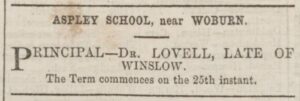

… then the next month he was selling off some spare carriages and horses in the Beds. Times:
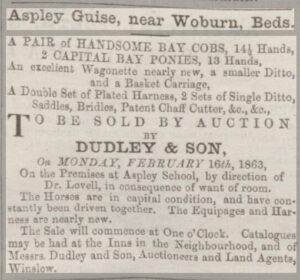
He had obviously just started running the school at Aspley, as the inhabitants of Winslow presented him with a parting gift in February 1863. The Bicester Herald:
WINSLOW PRESENTATION OF TESTIMONIAL The inhabitants of Winslow, on Monday the 16th inst., presented Henry Lovell, Esq., D.C.L., late of the Hall, Winslow, but now of Aspley Guise, near Woburn, with a substantial testimonial of their esteem, consisting of a very elegant and massive silver salver and claret jug, or loving cup. The presentation took place at Aspley, and was entirely of a private character.
A fuller report appeared in the Bucks. Advertiser, saying Lovell had purchased the building in Aspley Guise for “more commodious school premises”. He had spent the last 14 years in Winslow, being a tenant of William Selby-Lownes, a family who had connections to nearby Wavendon.
Within just a few months, more sporting fixtures commenced. In May, Lovell’s school welcomed Bedford Grammar School for a cricket match at Aspley “on the ground of the latter, which was not in so good condition as one could have wished, not having been used since the closing of the late Aspley school, upwards of twenty years ago.” Aspley won and both teams were treated to tea in Dr. Lovell’s house afterwards.
The Beds Mercury reported on a cricket match in August 1863, “Aspley Guise v. Dr. Lovell’s School”. The village had played against a combined team of scholars and Masters and had “given them a tremendous licking”. The School team was listed as Pinnock, Quintin, T. Buckell, H. Buckell, Fitzroy, Lowndes, Parrott, Cropp, Cox, Huish, Woodman and Lowndes (again) but there is no indication of which were pupils and which Masters. The school made 94 in two innings, while the village had scored 289 from their one.
A similar report in May 1864 in the Bucks. Advertiser shows they had played a second Eleven from Bedford Grammar School at Aspley, which the home school won with four wickets spare. The team from Aspley School was H. Bucknell, Quentin, Naylor, Lovett, W. Parrot, Cropp, J. Parrott, Mahon, Hone, M. Lowndes and F. Eve. Then the Leighton Buzzard Observer in September reported on a game between the schools of Mr. Lovell and a Mr. Gotto, as well as another between Aspley School and Aspley village. In the latter, the school team was listed as Weight, Kearsley, E & W Bucknell, R. Olphert, C. Quentin, E. Mahon, Halstead, Allpey, Pain and Turner. The school won comfortably.
The Post Office directory of 1864 included the new school in its preamble to the entry for Aspley Guise:
Aspley School, of rather ancient date, has lately been purchased by Dr. Henry Lovell, formerly of Winslow and Manheim, and about fifty resident pupils, sons of gentlemen, are prepared for the universities and public schools.
The next year, in May, Aspley School played against a team from the National School of Aspley Guise. Weight and Quentin are the only players named. After the match, Dr. Lovell treated both teams to tea in the school dining hall. It was mentioned that the football team was shortly to play Bedford Grammar school. An advert in the Evening Freeman of 8th January 1867 gave the new prices of education at Aspley Guise:
ASPLEY SCHOOL, BEDFORDSHIRE, Conducted by Dr. LOVELL. Candidates are prepared for the Public Schools, the Military Colleges, Army and Navy Examinations, and the Universities. The terms are from Fifty to Eighty Guineas per annum, according to age at entrance. All further information can be obtained of the Principal. The vacation will end on 26th inst.
In May 1867, Aspley School played cricket against Woburn School, which had been started by an Aspley ex-pupil and later Assistant master back in the 1790s. Aspley’s team were listed as E. & H. Bacchus, E. Hewlatt, J. Hare, C & J Clarke, Holmes, Brandon, F. & G. Hayter and Field. Woburn won by a mile.
Lovell, too, put reminders in the press of when terms started, which also served as advertising, as well as full adverts too. This reminder was in Saunders’s News-Letter, in January 1868:

… and this full advert in the Bucks Herald July 1868:
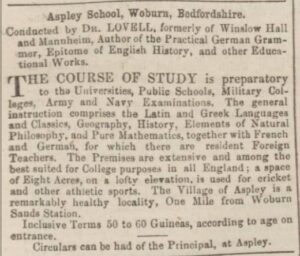
Publications further afield were used too. This is from the Birmingham Daily Gazette in April 1869:
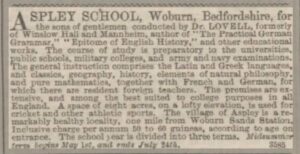
A prospectus for the School still existed in October 1948 when a columnist in the Beds. Times used it for an article. Lovell was listed in an 1869 Trade Directory as at ‘Aspley Collegiate School’ but he died later that year on 18th December. Arrangements for his replacement seem to have already been in hand.
The Beds. Times ran the usual advert for the school reopening in January 1870 but it was now under the Headmastership of Rev. C. P. Humble B.A., St. John’s College, Cambridge. The domestic arrangements would remain under Mrs. Lovell. Humble had come from Ilminster in Somerset, where he had been advertising his want of a position as curate and tutor in November 1869, having just moved there from Leamington. By May 1871, he had his own church in Preston, so had moved on from Aspley quite quickly. Mrs. Lovell seems to have sold up her residence in Aspley in August 1870, perhaps deciding she could not keep the school going herself. The Leighton Buzzard Observer 9th August 1870:
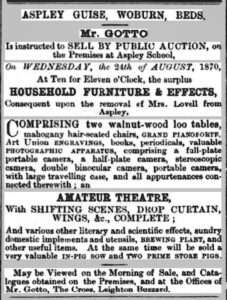
1870-1874 – Charles Ewart Butler
Mrs. Lovell kept ownership of the school buildings, but the school itself was taken over by Charles Ewart Butler – a master not recorded in A.E.A. Wright’s research at all. Born 1845, he graduated from Christ Church Cambridge in 1869 and had worked as an Assistant Master at Hillbrow School, Rugby. The first mention of him at Aspley comes from a whole year of weekly adverts I found in the Bradford Observer from September 1870. It seems an odd choice of place to advertise a school in Bedfordshire…Perhaps other provincial papers ran the same item but have not been digitised yet.

…but from April the next year he started adverts in the Beds. Times too:

The school and pupils were captured on the 1871 census. Under no.6 Church Street, Aspley Guise, Butler is listed with his two sisters, two assistants, four servants and 18 pupils which included the previous headmaster’s son:
Charles E. Butler, Head, unmarried, 26, Schoolmaster and Curate, born St. Johns Wood
Olivia L. Butler, sister, unm, 21, – , St Johns Wood, London
Gertrude F. Butler, sister, unm, 18, – , St Johns Wood, London
William Fisher, Assistant, unm, 38, Assistant Master, Deamsadt[?], Swartzburg
Charles Young, Assistant, unm, 24, Assistant Master, Stanwick, Northants.
Susan Fleen, housekeeper, widowed, 42, Housekeeper, St. Michaels, Bath
Bernard Fountaine, pupil, unm,16, scholar, Stoke Hammond, Bucks.
George Hardman, pupil, unm, 17, scholar, Edenfield, Manchester
Harry Selfe, pupil, unm, 17, scholar, Aylesbury, Bucks.
Robert A. Smith, pupil, unm, 17, scholar, Dublin, Ireland
Henry C. G. Brandreth, pupil, unm, 14, scholar, Houghton, Beds.
Robert F. Doulton, pupil, unm, 14, scholar, Biggleswade, Beds.
Edward Hungerford, pupil, unm, 15, scholar, Dingley, Northampton
Thomas J. Skipton, pupil, unm, 15, scholar, Slendermouth[?], Ireland
William D. St. Ledger, pupil, unm, 16, scholar, Ipswich, Suffolk
David Bromilow, pupil, unm, 14, scholar, St Helens, Lancs.
Charles N. Doulton, pupil, unm, 12, scholar, Biggleswade, Beds.
Harry P. Friswell, pupil, unm, 14, scholar, Lloyd Square, London
Edward A. Lovell, pupil, unm, 14, scholar, Winslow, Bucks.
Francis Playfair, pupil, unm, 11, scholar, Bengal, India
Robert Steele, pupil, unm, 11, scholar, Greenock, Scotland
Harry A. Playfair, pupil, unm, 10, scholar, Bengal, India
Reginald C. Saunders, pupil, unm, 10, scholar, Bengal, India
Horace Skipton, pupil, unm, 9, scholar, Leamington, Warwick
Ann Woolfe, Servant, unm, 28, Domestic Servant, Hill Wootton, Warks.
Ann Tilley, Servant, unm, 19, Domestic Servant, Pailton, Warks.
Mary Matthews, Servant, unm, 18, Domestic Servant, Aspley, Beds.
Henry Tipple, Servant, unm, 18, Domestic Servant, Aspley, Beds.
William Bransan, Servant, unm, 19, Domestic Servant, Staverten, Northants.
Butler also liked to put on musical events with his charges. The Beds. Times of 30th December 1871:
Aspley Guise. The Rev. Charles Ewarts Butler, Head Master of Aspley School, gave a musical and dramatic soirée, on Friday, Dec. 22, before breaking up for the Christmas holidays. We subjoin the programme. Herr Bitz is a finished musician and the duets with two of the elder pupils, E. L. Hungerford and W. D. St. Ledger, Esqs., were well given. The singing of “Integer Vitae”, “Children’s Voices” and “Hybrias The Cretin” were much admired – the fine bass of Mr. Butler being especially suited to the latter. The drama of “The Jacobite” by T. R. Planché was entirely acted by the boys, and so well done that we need only say the curtain fell with loud applause. At the conclusion the National Anthem was sung, when the following verse, written by the Rev. C. E. Butler, was added for the Prince of Wales, and sung by the whole audience.
Lord, hear our nation’s voice,
Long may our hearts rejoice,
In Britain’s Prince.
Unite us round the throne,
In Church and State as one,
Bless England’s eldest son,
God save the Prince.
Programme:
Glee – “Since first I saw your Face” – Ford.
Duetto – Fantasie pour La violin, accomp. de piano.
“Lucy de Lammermoor” – Opera de Donnavetti
Madame and Herr Bitz
Part Song – “All among the Barley” – Stirling
Duetto. – Waltzer. am Schonam Rhein – Bola
Pianoforte – E. L. Hungerford; violin Herr Bitz.
Song (Duet) – Madame & Herr Bitz.
Song (with Chorus) “Old England Yet” – Benedict
H. Dunton
Duetto – “La Sumnumbula” – Bellini
Violin Herr Bitz; Piano W. D. St. Leger
Part Song – “Integer Vitae” – Fleming
Glee – “To all you Ladies” – Callcot
Song – “Children’s Voices” – Claribel
F. Douton
Five juvenile Part Songs – Silcher
Song – “Hybrias the Cretan” – Elliott
Rev. C. E. Butler
Song – Herr Bitz
“The Jacobite” – A comic drama, by T. E. Planché
Sir Richard Wroughton – W. St Leger
Major Murray – E. L. Hungerford
John Duck – O. H. Vessey
Lady Somerford – R. F. Douton
Widow Pottle – E. A. Lovell
Patty Pottle – H. F. Friswell
God Save the Queen
A few private photos of the school, which once belonging to ex-pupil John Spencer Ewart, (later General Ewart of the Queen’s Own Cameron Highlanders) came up for sale about 20 years ago.
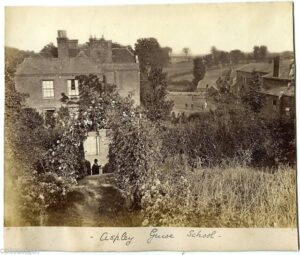
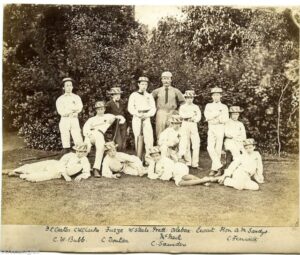
Ewart is named on the team above and the vendor also thought he was the third boy standing from the left on the one below:
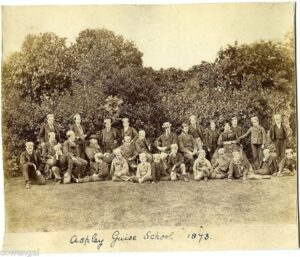
It was very unusual for a tradesman to need to summon a vicar over a debt – tongues would have been set wagging in the village – but H. G. Fisher, a local printer and bookseller of Woburn, claimed Butler owed him £10 in December 1873. Butler did not appear at Court to explain himself and Fisher proved his debt, so the Schoolmaster was given a week to pay it. Was this a sign of some financial difficulties? Very soon afterwards, the school had been closed-up for the final time. Butler held a grand sale and moved on to pastures new. The Bucks Herald, 21st February 1874:
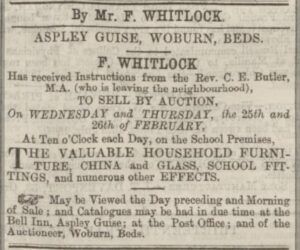
With education at an end and the school contents now gone, the building could be disposed of. The house was duly advertised in the Daily Telegraph of 30th June 1874. All the school buildings were sold for £22,000. The sale particulars [GA2150] describe the property in detail:
Bedfordshire. With possession, the particulars and conditions of sale of a valuable freehold property, situate in the picturesque and healthy village of Aspley Guise, about one mile from the Woburn Sands station on the North Western Railway, known as the Aspley Schools.
Established for over a century and a half, comprising a private residence with accommodation for about 50 pupils, with the necessary staff of masters, servants, etc. Extensive stabling, coach house, laundries, brewhouse and 9 acres of land, including well planted pleasure grounds and lawn terrace garden, large open and covered playgrounds and a capital pasture field available from its position and the beautiful views it commands, for the erection of one or more residencies which will be sold by Messrs. Edwin Fox and Bousfield at the Mart, Tokenhouse Yard, Bank of England, on Wednesday the 15th of July 1874 at Two o’clock precisely.
Particulars. A valuable freehold property comprising substantial and commodious premises, lately used as schools, distinguished as the Aspley schools situate in the picturesque and healthy village of Aspley Guise in the County of Bedford, being about one mile from the Woburn Sands station on the Northwestern Railway. They have been established for over a century and a half, and with the Residence have from time to time been enlarged, improved, and fitted up with every modern appliance by each successive master. They are arranged to accommodate 50 pupils, and the necessary staff for masters and servants.
The Private Residence, which is screened from the public road by shrubberies &c. contains on the Ground Floor – Hall, Drawing, Dining and Breakfast Rooms, with Six Bedrooms and W.C. In the Basement – Kitchen, Scullery, Larder, Housekeeper’s Room, Cellars, and other requisite conveniences for a large establishment. At the rear is a private lawn and pleasure grounds laid out with taste, and in connection therewith is a Small Conservatory. There is extensive Stabling, Coach-house, Laundries, Brew-house, Sculleries &c., and above are roomy lofts for hay and straw, warehouse room, and other storage. A portion of the upper story [sic] has been reserved, and fitted up as a Range of Dormitories, to be used in illness or other pressing circumstances or emergencies.
To the west of the private residence, divided therefrom by the playground (which is fitted with leaping bar and other conveniences to form a gymnasium) are the Sitting Rooms and Bedrooms for the Masters and Ushers, and Dormitories for the pupils, with an Extensive Dining Saloon accessible from the Kitchen of the Residence by a tunnel under the playground. There is also the library of the masters opening by French windows to playground well placed for the supervision of the scholars; adjacent are two other extensive school buildings. beneath the school rooms and opening into the playground is a large covered area for the use of the pupils in rough and rainy weather; there are also two private sitting rooms for junior masters. The lavatories, W.C.’s, urinals &c., are complete with every convenience.
Opposite the Residence, and divided therefrom by the public road, is the terrace garden of over half an acre in extent, laid out in terrace beds, and planted with the most productive fruit and vegetables; bounded by and adjoining the public road, and above the terrace gardens is the far-famed “Powage”. The pupils’ cricketing and summer playground is eight acres in extent, and apart from the productive nature of its soil, commands some of the finest views in the county. The soil is sand, the water plentiful and pure, and the air considered the most healthy in the Kingdom. A portion of the land from its position and the lovely views it commands might be used for the erection on one or more residences, while the remainder would be sufficient for the wants of the establishment, thus without detriment to the estate securing a reduction in the price.
In local hands is an epitome of title for the buildings which show a Conveyance from Anna Franziska Lovall to Mr. John Kemp on 10th July 1875.
A writer in the Beds. Times in November 1912 says Butler moved his school to Eastbourne, but I can’t find any evidence of this at all. Butler moved on to Thanet Collegiate School in Margate for a while but was appointed as Master of the new Llandaff Cathedral school in February 1880. (London Evening Standard) After ten years there, he became vicar of Nunkeeling with Bewholme in Hull, then served as Headmaster of Hull Grammar School 1887-93 and was responsible for the period in which the school moved to a new site, started several sporting clubs and an Old Boys network. He published a “Directory of Musical Education”, a guide to choir-schools, degrees in music and public schools specialising in music. Returning to running a parish church, he took on Hotham in Yorkshire, but it seems the parish went broke and he locked the church and absconded in 1897. He died in May 1919.
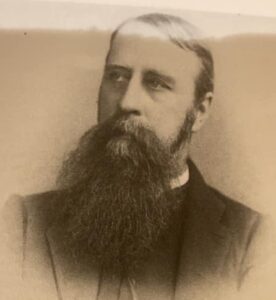
From 1875, the Aspley Guise School buildings became the home of the Powage Press, a printing firm owned by John Kemp, founder and proprietor of “Kemp’s Mercantile Gazette”, who adopted the name of an area of ground which came with the house for his firm and also the building by the road. His business had previously been housed in the old Baptist chapel at Woburn but this was found to be too small for his printing presses. The Powage Press was still there in 1911 when a fire consumed much of the building by the road, but it was quickly rebuilt and printing continued. It expanded to having 21 offices at one point. That business survived into the 21st century. Some of their corporate literature (1998) mentions tunnels being found between the buildings.
In 1909, George Herbert Fowler, later the County archivist of Bedfordshire, lived at The Old House in Aspley and became interested in the school. He went as far as trying to locate ex-pupils and sending them a pro-forma questionnaire to collect their memories of the school – his letter sent out exists in his papers at Bedford [X364/83 & 85] but there seems to be no replies stored.
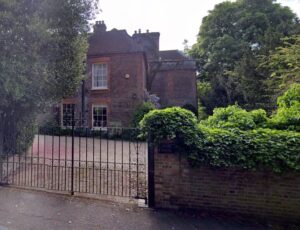
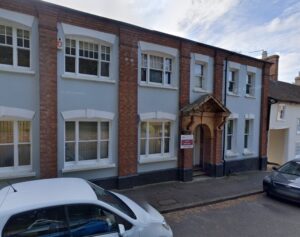
Notes from Various Obituaries of Past Pupils:
- Rowland Rowse of Market Harborough, in June 1823 (Northants Mercury) “…was educated at Aspley School, at that time in great repute”.
- Thomas Gibbs in February 1849 (Kentish Gazette) who founded Thomas Gibbs & Co. seed merchants.
- Hain Friswell in March 1878 (Darlington & Richmond Herald) “genial editor of the Family Herald” and Gentle Life series.
- John Torr, January 1880 (Liverpool Weekly Mercury) Conservative M.P. for Liverpool.
- Carlisle Spedding Parker, J.P. in January 1889 (Beds Mercury). He attended under Richard Pain and loved Aspley so much he bought The Rookery estate in later life.
Appendix 1
“A List of the Young Gentlemen of Aspley Academy Near Woburn, Beds.” 1788. [OR2071/390]
Adams – Burcott, Bucks.
Addis – Hammersmith, Middlesex
Ager Snr. – Fenny Stratford, Bucks.
Ager Jnr. – Fenny Stratford, Bucks.
Airth – Bermudas, Somerset
Austin – Whetstone, Middlesex
Bailey – Bedford
Barnett – 28 Great James Street, Bedford Row
Baxter – Newport Pagnell
Bilbie – Derbyshire
Bradbury Snr. – Union Street, London
Bradbury Jnr. – Sharps Alley, Cow Cross
Bryant – Newmarket, Suffolk
Cathrow Snr. – 21 Weymouth Street
Cathrow Jnr. – 21 Weymouth Street
Cherry – Hertford
Chibnall – Newport Pagnell
Chubb – Sherington, Bucks.
Cooke Snr. – Brockhill Hall, Notts.
Cooke Jnr. – Brockhill Hall, Notts.
Crofts – Raunds, Northants.
Curmer – Paris, France
Dilbey – Haynes, Beds.
Duke – Newland, Northampton
Flesher – Towcester, Northants.
Fox – Flushing, Holland
Foxdew – Staveley, Derbyshire
Gardner – Olney, Bucks.
Geeves – Page Street, Hendon, Middlesex
Golby – Stony Stratford
Grime Snr. – Aylesbury, Bucks.
Grime Jnr. – Aylesbury, Bucks.
Green Snr. – Bedford
Green Jnr. – Bedford
Green – Cheapside
Hagar – Ampthill
Harrison – Wolverton
Hart Snr. – Highgate, Middlesex
Hart Jnr. – Highgate, Middlesex
Hastie – 74 Great Portland Street
Hays – Brighthemstone, Sussex
Herisman – Pitchley, Northants.
Hill Snr. – Lower Hale, Hendon
Hill Jnr. – Lower Hale, Hendon
Hill Minimus – Lower Hale, Hendon
Holman Snr. – Ostend, Flanders
Holman Jnr. – Ostend, Flanders
Hawkins – Hardenbury, Herts.
Ibberson – George & Blue Boar, Holborn
Jefferson – Newport Pagnell
Jenning Snr. – Port Royal, Bermudas
Jenning Jnr. – Port Royal, Bermudas
Johnson Snr. – Northampton
Johnson Jnr. – St. Albans
Keep Snr. – Kettering, Northants.
Keep Jnr. – Kettering, Northants.
Kent Snr. – Wavendon, Bucks.
Kent Jnr. – 116 Holborn, London
Lawford – Towcester, Northants.
Littlejohn Snr. – Belmount, Jamaica
Littlejohn Jnr. – Belmount, Jamaica
Lord – Winslow, Bucks.
Lorken – St Johns Street, London
Lotan – George St, St. Albans
Mallet – Great Harwood, Bucks.
Marsden Snr. – Curton Row, Moorfields
Marsden Jnr. – Curton Row, Moorfields
Marshall – Northampton
Marsh Snr. – Montpieles Row, Twickenham
Marsh Jnr. – Montpieles Row, Twickenham
Massey – No.22 Holles Street, Cavendish
Milward Snr. – Northampton
Milward Jnr. – Northampton
Morgan – Northampton
Morris – Milton Bryant, Beds.
Moss – No.9 Gerard Street, Soho
Odell – Leighton Buzzard, Beds.
Oger – Paris, France
Oliver Snr. – Stony Stratford
Oliver Jnr. – Dunstable, Beds
Orlebar Snr. – Hinwick House, Beds.
Orlebar Jnr. – Hinwick House, Beds.
Osborn – Newport Pagnell
Otter – Mansfield, Notts.
Parnlker – No.13 London Street, Fenchurch
Pedley Snr. – Great Barford, Beds.
Pedley Jnr. – Great Barford, Beds.
Parry – Sharnbrook, Beds.
Parvis – Greenwick, Kent
Pell – Overstone, Northampton
Pickford Snr. – Markyate Street
Pickford Jnr. – Markyate Street
Price – Leighton Buzzard
Reynolds – No.8 Penton Place
Richards – Oxford Street
Rogers – Newport Pagnell
Rosell – Ostend, Flanders
Russell – Letchborough, Northants.
Sears – No.32 Henriella Street
Small – No.236 Oxford Street
Smith Snr. – Nottingham
Smith Jnr. – Olney, Bucks.
Smith Snr. – Bridge Street, Black Fryar
Smith Jnr. – Bridge Street, Black Fryar
Stapleton Snr. – Cranfield, Beds.
Stapleton Jnr. – Cranfield, Beds.
Stapleton Major – Cranfield, Beds.
Stapleton Minimus – Cranfield, Beds.
Struth – No.380 Oxford Street
Stocdale – Opposite Burlington House, Piccadilly
Thorpe – Newmarket, Suffolk
Tissot – Paris, France
Turnbull – Winslow, Bucks.
Turnbutt – Oxton Hall, Derby
Twycross – No.3 Penton Ville, Islington
Walker – Cosgrove, Bucks.
Watts – 21 Rochester Row, Tothill Field
Wagstaff – Olney, Bucks.
Wagstaff – Olney, Bucks.
Williams – Hampstead
Willis – Bletchley, Bucks.
Wilson – Fulham, Middlesex
Winslow – 51 St Paul’s Church Yard
Whitmill – Chanvelton, near Daventry
Wright Snr. – Nottingham
Wright Jnr. – Nottingham
Day Boys
Cole – Aspley, Beds.
Askew – Aspley Beds.
Apprentice
Daniel – Eversholt, Beds.
Page last updated Dec. 2023.
